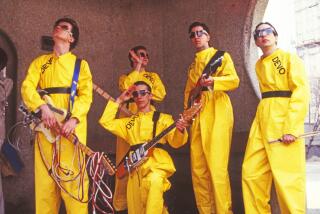Filmmaker Takes 25 Years to Deliver Muddled ‘Message’
- Share via
“Message to Love,” Murray Lerner’s documentary on the Isle of Wight Festival, has been a source of frustration to the filmmaker for 25 years. That’s how long it took him to get the money to make a proper film from footage he’d shot of the 1970 five-day musical extravaganza.
The BBC finally provided Lerner with the completion funds, so the film opens today--and now it’s the viewers’ turn to be frustrated: Lerner’s film contains far too much footage of the festival’s behind-the-scenes squabbling and not nearly enough of the music.
Much has been made of the importance of “Message to Love” as a record of the moment when flower power got trampled in the dust, but anyone who says that doesn’t know their history. By the time Britain’s Isle of Wight was invaded by 600,000 hippies, several signal events had already occurred: The Manson killings and the muddy spectacle of Woodstock had both taken place the previous summer, and eight months prior to the Isle of Wight, a Rolling Stones gig at California’s Altamont Speedway had erupted into chaos and murder.
The nightmare of Altamont was the subject of “Gimme Shelter,” a documentary by the Maysles Brothers released in 1970, so the fairy dust had been wiped from most people’s eyes by the time all those stoned music lovers began lining up for the ferry to the Isle of Wight. Consequently, Lerner’s footage of the festival’s exasperated promoters--who have all the dignity of characters from a Monty Python skit--seems more than a little disingenuous.
These people were surprised they ran into problems? All they had to do was pick up a newspaper to know things were not going well with the counterculture. Lerner’s film focuses on the troubled relationship between art and commerce, but that too is old news. It was alluded to in Michael Wadleigh’s 1970 film, “Woodstock,” and explored in depth last year in “Hype!,” a film charting the exploitation of Seattle’s music scene.
More serious, Lerner’s editing choices are consistently baffling. Why must we sit through every bloody note of the Moody Blues’ “Nights in White Satin” when we’re given just a glimpse of Miles Davis performing “Call It Anything”? We get several songs and a drum solo by Emerson Lake & Palmer, but why just a few seconds of Leonard Cohen?
“Message to Love” is, of course, not without redeeming moments. Kris Kristofferson (who seems not all there) gazes out at the acres of audience, flatly declares, “I think they’re gonna shoot us,” sings a few bars, then makes an abrupt exit that seems to say “the hell with it.” Joni Mitchell, whose powerful voice was one of the few equal to the scale of this event, exuded a moving and sweet earnestness.
The Doors’ Jim Morrison, who died the year after the festival, turns in a riveting performance freighted with weariness and foreboding--by 1970 he seemed very much a haunted man. And Jimi Hendrix is absolutely sensational. Just 28 at the time of this performance, he seemed to have a hotline to an entirely different realm that was erotic, vaguely evil and older than time, and his music unleashed something of such primal power it almost defies description.
Watching Hendrix in Lerner’s film, one realizes that we’re all well-versed in the sociology of the ‘60s by now--the decade’s great music, however, remains ever mysterious. Would that there were more of it in “Message to Love.”
* MPAA rating: Unrated. Times guidelines: some strong language and nudity.
(BEGIN TEXT OF INFOBOX / INFOGRAPHIC)
‘Message to Love’
Strand Releasing presents a Pulsar Production for the BBC and Castle Music Pictures in association with Initial Film and Television. Producer and director Murray Lerner. Executive producers Geoff Kemplin, Rocky Oldham, Malcolm Gerrie, Avril Macrory. With Jimi Hendrix, the Doors, the Who, Donovan, Miles Davis, Joan Baez, Leonard Cohen, the Moody Blues, Emerson Lake & Palmer, Tiny Tim, Joni Mitchell, Jethro Tull. Running time: 2 hours, 8 minutes.
* At the Nuart, 11272 Santa Monica Blvd., West Los Angeles, (310) 478-6379, and Edwards University, 4245 Campus Drive, Irvine, (714) 854-8811.
More to Read
Only good movies
Get the Indie Focus newsletter, Mark Olsen's weekly guide to the world of cinema.
You may occasionally receive promotional content from the Los Angeles Times.








